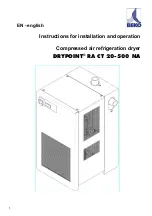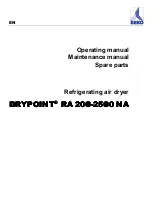
© 2017 PoolPak LLC. All rights reserved.
ComPak
®
Series - Installation, Operation and Maintenance |
9
ComPak
®
Series IOM
POOL TYPE
WATER TEMP (°F)
AIR TEMP (°F)
ROOM RH %
Recreational Pool
80 to 85
Water Temp + 2
55 to 60
Therapy Pool
86 to 92
86
1
55 to 60
Whirlpools
99 to 104
86
1
55 to 60
Table 1-1. Typical Pool Water & Air Temperature Set-Points
1
Normally max 86°F to minimize overheating of occupants
Indoor Air Quality
Pools and water parks with water features have a higher evaporation rate than a standard pool because of
the increased water surface area. Chloramines (See Pool Water Chemistry below), which are present in the
water, become more concentrated in the air as the “water to air” interactions increase, affecting the indoor air
quality. A strong “chlorine” odor is an indicator of poor pool water chemistry, and is generally offensive to the
occupants. Higher levels of chloramines can cause skin/eye irritation and respiratory problems commonly known
as “lifeguard lung”.
Most poolrooms are designed with a minimum ventilation rate to dilute the airborne pollutants generated from
the chemical interactions in the pool water. Typically these rates are based on ASHRAE standard 62.1 and
dictated by local codes at about 0.5 CFM/ square foot of pool and deck area, but depending on the pool
water chemistry the ventilation rate may not always be adequate for good poolroom indoor air quality.
However, increasing ventilation rates can significantly add to the cost of operation. Including energy
conservation strategies such as heat recovery, airflow measurement and CO2 based control help control costs
while improving indoor air quality.
Depending on the geographic location and season of the year, treating the outside air has a direct effect on
energy consumption. Some facilities prefer higher than minimum ventilation rates, up to 100% of OA,
to maximize indoor air quality, but the cost of treating this air can be significant.
Occupant Comfort
Occupant comfort in a natatorium is easy to understand. If you ever swam in an outdoor pool on a cold,
windy day, or exited a pool in a dry, desert location--you will probably notice an immediate chill. The opposite
is true where high humidity is not adequately controlled either through ventilation or by mechanical means.
The moisture level can reach such a state where it is oppressive or stuffy. Common complaints are difficulty in
breathing and the room being perceived to be warmer than the actual dry bulb temperature would suggest.
Regardless of the source of discomfort, users will not enjoy the facility if water/air temperatures and humidity
levels are not within a narrow range. Ideal water temperature is around 82° with the air temperature about 2
degrees F higher to prevent chilling when exiting the pool and to minimize evaporation from the pool surface.
Here are some recommended temperatures for poolrooms, which can be adjusted to meet specific needs of
bathers. In general, “active” poolrooms are maintained at lower temperature ranges so the users don’t overheat,
warmer temperatures are more common for seniors or children or less active pools.
The desirable humidity range is generally between 50% and 60%--greater than 60% creates a sticky feeling
and/or difficult breathing, and low humidity results in evaporative cooling on the bather’s skin, resulting in a
chill.
Poor air movement caused by improper duct placement within the poolroom will also lead to occupant
discomfort. Excessive supply air blowing on bathers can create drafts, while uneven air distribution may create
stagnant zones within the space.










































